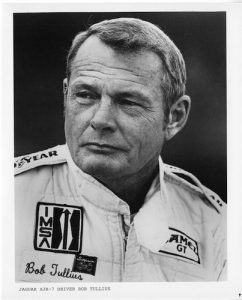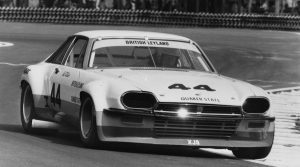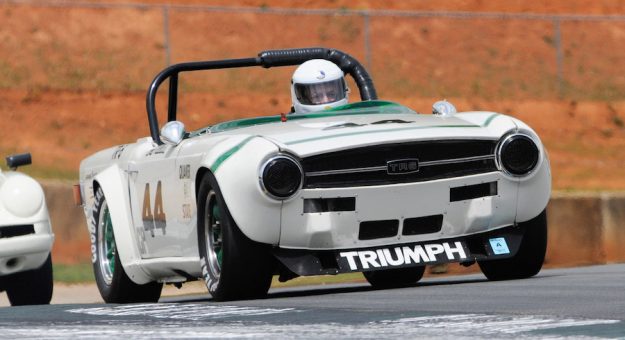There was without a doubt a time when a lot of people figured road racing in this country was all about amateur racers politely slicing at each other in foreign-built sports cars, enjoying the camaraderie and basically having a good time. Road racing was the playground of weekend enthusiasts.
Competitors who raced for money and stardom generally stuck to oval tracks and drag strips, where wins meant more than plated cups. It was all good, gentlemanly entertainment.
For some people, anyway.

A few of the others, like Bob Tullius, had an added measure of ferocity and determination that initially seemed out of place among the hobbyist racers that typified early sports car ranks. Tullius was, and is, different. With a drive to compete honed on the hallowed gridirons of upstate New York, an unmistakable military bearing and the disciplined focus of a skilled aviator, Tullius was an immediate, and obvious, departure from the crowd.
He was a winner from the very first time he strapped into a sports car and essentially never stopped until he marched off to distinguished retirement. His competitive journey took him victoriously all the way to Le Mans.
And on the way, the team he founded put countless — literally — buyers into the seats of new British sports cars, looking for a sliver of reflected Group 44 Inc. magic.
“My military career was very brief,” Tullius, now 91, said from his hangar in Florida. “I got hurt playing sandlot football and the Air Force threw me out because I couldn’t climb on airplanes and such. I have limited use of my left knee and I can’t run, so that was it. This was 1948, ’49, when I was about 19.”
The military’s loss was more than erased by what sports car racing in America experienced once Tullius showed up. The son of a plumber from Rochester, N.Y., who originally hoped to play in the National Football League, Tullius returned to high school at age 19 and despite not graduating until 21, decided to become a teacher.
That ended when he got a job as personal assistant to a Buick dealer in Rochester. It was an epiphany, as dealer John Dorschel, a Notre Dame graduate, groomed his young understudy in the car business. Eventually, Tullius took a slot selling copiers for Kodak, the industrial giant of Rochester.
“That was around 1960,” he said. “I enjoyed my time at Kodak but I was also a square peg in a round hole, and my boss told me, ‘You need to be in business for yourself.’ Eventually, I ended up starting Group 44 Inc.”
Getting Tullius’ background out of the way up front is essential because those experiences framed everything he’s accomplished since then. Tullius was in the vanguard of a coterie of young American road racers turned team owners that would bring hard-eyed professionalism to the playground of sports cars. One could argue — and many have — that Tullius was Roger Penske before Roger Penske. In his case, the transformative journey began in Virginia, where Kodak had moved him.

“When I got out of the service, my first car was a 1935 Ford and I used to drag race it all over the county,” Tullius recalled. “One of the Kodak salesmen I trained in Washington, D.C., was a car guy and he took me to Marlboro, Md., which was an SCCA track. I sat in the stands, watched and thought, ‘Hmmm. I could do this pretty easily.’ I won the first race I drove in in 1961 and went on to become a national champion in 1962, ’63, ’64 and ’65.”
That first win, aboard his own Triumph TR3, also came at Marlboro. Nearly 30 years later and by this time a highly accomplished private pilot, Tullius also won in his final start, with an IMSA GTP car at Daytona Int’l Speedway.
In between, Tullius first persuaded Standard-Triumph to provide him with one of its new TR4 roadsters, given that he was already beating the TR4-armed works drivers with his older TR3. Tullius promptly stuffed his new TR4 into a couple of trees. Undeterred, he and mechanic Ed Diehl combined pieces from three wrecked TR4s to create one usable car, and kept on winning, straight to the D Production championship.
Freed from Kodak, Tullius was working for a Triumph dealership outside Washington when he wrecked another race car. One mechanic recommended Tullius hire a tall, uncommonly quiet local kid named Brian Furstenau to work on the car. Despite Furstenau’s lack of formal training, he proved immediately to be autodidactic and once on board, joined marketing whiz Dick Gilmartin as the nexus of Tullius’ pro-level amateur team, which he founded in 1965 and named Group 44 Inc. after the SCCA car number he’d personally selected.
When he did, Tullius also secured Quaker State as his major sponsor. One observer of the team has been Bill Warner, chairman emeritus of The Amelia, the landmark concours for historic automobiles in northeast Florida. He described the sponsorship as groundbreaking.
“You just didn’t see that in SCCA racing. Tullius demanded the best and with Brian Furstenau, he got it,” Warner explained. “It was a military-run operation and his people had to look the part, which through Quaker State, brought major sponsorship to the SCCA.”
Warner owns an ex-Tullius Triumph TR6, noting that unlike most competitors, Group 44 Inc.’s cars used the likes of acid-dipped bodywork.
Group 44 Inc. is a dominant, enduring name in the annals of modern American road-course competition.
Over the next 25 years, with Tullius as its field marshal, the team amassed more than 300 major race wins, capturing 14 national titles along the way in a variety of SCCA and IMSA classes. Most of those wins came aboard cars produced in England by Standard-Triumph and its corporate successor, British Leyland.
Group 44 wins came in Triumphs from the TR3 to the TR8, plus Jaguars including the E-type, XJS and XJR-5 prototype. But the team’s first pro-level win was doubly significant: In the very first SCCA Trans-Am race ever contested, at Sebring Int’l Raceway in 1966, Tullius paired with the late Tony Adamowicz to capture the over-2.5 liter win in a factory-backed Dodge Dart, of all things.
The car placed second overall — to future Formula 1 champion Jochen Rindt — but as Tullius defiantly declares, a win is a win. Just that quickly, Group 44 Inc. had made racing history.
“I was so angry at that overall thing that I spent the rest of my life trying to tell people that there’s no such thing as an overall winner,” he declares today. “You’re not racing against the people outside your class. People in the classes deserve just as much recognition as the overall people who end up on the podium.”
Group 44 Inc. became British Leyland’s main works-backed operation in the eastern United States. As Tullius puts it today, “All of our success was due to Furstenau and a formidable selection of drivers. They gave us money, we won the races and did our own PR work. We were an all-service racing company serving the same manufacturer for 28 years.”
Until his untimely death, while flying a plane owned by Tullius, Furstenau was a fixture in Group 44 Inc.’s success for almost its entire existence.
“Brian didn’t have that much in the way of formal education and he was always a really quiet person, but he was a genius mechanically,” Tullius said. “One of the things I really regret is that we never got anything going for Indianapolis because I know Brian would have been a real success there as a team engineer. Sometimes, he wouldn’t say a word. But he knew more about life — not just cars — than anybody else I met. He would have been a star. I can say unequivocally that without him, I would have never got where I did. He was with me 20 years.”
Tullius rejuvenated the career of Hurley Haywood by putting him in a Jaguar while he recuperated from a serious racing injury. Haywood won several IMSA races for Group 44 Inc. before winning the Trans-Am title with the team aboard an Audi 200 Quattro.
“Bob ran a really tight ship, which is what you really need as an owner, a manager and driver,” Haywood recalled. “He hit all those buttons at once.”
Tullius estimates that as a driver, he won something around 100 individual SCCA races, plus three Trans-Am championships for Jaguar, two of them consecutively, along with 11 IMSA victories.
The Le Mans outings are bittersweet today, having used naturally aspirated V-12s that couldn’t match the Porsche 962s turbocharged power. Besides his outings with Dodge, Tullius has dabbled with other American iron, driving his final Trans-Am races in the Grey Ghost Pontiac Tempest of engineer Herb Adams, and fielding Pontiacs for Jim Sauter in the NASCAR Cup Series during the late 1980s.
Stepping away from racing after Furstenau’s passing, Tullius maintains a collection of race cars and aircraft, including his authentic P-51 Mustang fighter, which is now in the collections of the RAF Museum in Hendon, England.
“My most cherished races are the ones I won,” he smiled. “Usually, that’s too many to talk about.”
